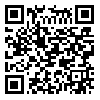Volume 68, Issue 4 (6 2010)
Tehran Univ Med J 2010, 68(4): 207-212 |
Back to browse issues page
Download citation:
BibTeX | RIS | EndNote | Medlars | ProCite | Reference Manager | RefWorks
Send citation to:



BibTeX | RIS | EndNote | Medlars | ProCite | Reference Manager | RefWorks
Send citation to:
F N, Sh F, P K, B C, N E, A M, et al . ARMS-PCR Versus AS-PCR to evaluate JAK2V617F mutation in patients with non-CML myeloproliferative neoplasms. Tehran Univ Med J 2010; 68 (4) :207-212
URL: http://tumj.tums.ac.ir/article-1-348-en.html
URL: http://tumj.tums.ac.ir/article-1-348-en.html
Nadali F 
 , Ferdowsi Sh
, Ferdowsi Sh 
 , Karimzadeh P
, Karimzadeh P 
 , Chahardouli B
, Chahardouli B 
 , Einollahi N
, Einollahi N 
 , Mousavi A
, Mousavi A 
 , Bahar B
, Bahar B 
 , Dargahi H
, Dargahi H 
 , Toogeh GhR
, Toogeh GhR 
 , Alimoghaddam K
, Alimoghaddam K 
 , Ghavamzadeh A
, Ghavamzadeh A 
 , Ghaffari SH *
, Ghaffari SH * 
 1
1

 , Ferdowsi Sh
, Ferdowsi Sh 
 , Karimzadeh P
, Karimzadeh P 
 , Chahardouli B
, Chahardouli B 
 , Einollahi N
, Einollahi N 
 , Mousavi A
, Mousavi A 
 , Bahar B
, Bahar B 
 , Dargahi H
, Dargahi H 
 , Toogeh GhR
, Toogeh GhR 
 , Alimoghaddam K
, Alimoghaddam K 
 , Ghavamzadeh A
, Ghavamzadeh A 
 , Ghaffari SH *
, Ghaffari SH * 
 1
1
1- , shghaffari@tums.ac.ir
Abstract: (8357 Views)
Background: JAK2 is a nonreceptor tyrosine kinase that plays a major role in myeloid disorders. This mutation is characterized by a G to T transverse at nucleotide 1849 in exon 12 of the JAK2 gene, located on the chromosome 9p, leading to a substitution of valine to phenylalanine at amino acid position 617 in the JAK2 protein. In this study we compared the amplification refractory mutation (ARMS) assay and allele- specific (AS- PCR) to evaluate JAK2V617F mutation patients with non-CML myeloproliferative neoplasms (MPNS).
Methods: In this experimental study we evaluated JAK2 mutation in 58 patients with a known or suspected diagnosis of a myeloproliferative neoplasm by simple randomized sampling. The mutation was detected by ARMS-PCR and AS-PCR in patients. In order to verify the methods, amplified products from some patients were sequenced.
Results: The JAK2 V617F mutation was detected in 86.6%(26/30) of patients with polycythemia vera and 61.5%(8/13) of patients with idiopathic myelofibrosis by ARMS-PCR and AS-PCR. 46.6%(7.15) of essential thrombocythemia patients were positive using
ARMS- PCR method while 53%(8.15) of then were positive when AS- PCR were used. The mutation was confirmed by sequencing.
Conclusions: The incidence of JAK2 mutation using above PCR methods is similar to previous studies. The different results may depend on the molecular technique used
Send email to the article author
| Rights and permissions | |
 |
This work is licensed under a Creative Commons Attribution-NonCommercial 4.0 International License. |



